About the Autumn Olive

Autumn Olive (also called Autumn Berry, Japanese Silverberry, or Spreading Oleaster) is a bush that is native to China and is considered an “invasive” in the USA. In a good part of the 20th century, it was used extensively by the US Army Corp of Engineers to hold hillsides in place from the growing highway system spanning the US and to fix nitrogen. The Autumn Olive grows exceedingly quickly; it can rise up several feet in a few months and bush out. It also spreads rapidly due to its berries being a favorite of birds. It is a nitrogen fixer, so it is often found in abused land areas or landscape areas that are regenerating (like old farmer’s fields or industrial sites); I should add that its one of the few non-legume nitrogen fixers we have and it does fill an important role in the ecosystem. It is extremely prevalent here in Michigan; I’ve also seen it in Indiana and Ohio and in the warmer parts of PA (like Bedford county). If you search invasive plant sites or talk to people, they will often call this plant a menace plant. And while this bush does spread quickly, it does have its benefits, especially in the form of beautiful, tasty, autumn olive berries with their incredible cranberry-like tart and sweet flavors.
The fruit is extremely high in lycopene (up to 17 times more than tomatoes, according to a USDA report described in the linked article). The fruit also contain high levels of Vitamins E, A, flavionids, and fatty acids. Underripe fruit are high in tannins and are very astringent, but as they ripen, they get much sweeter (especially after a bout of cold weather!) I know that there are people exploring commercial cultivation of this plant due to the berries’ nutritional value and the plant’s ease of growing. And they are super tasty!
Harvesting Autumn Olive
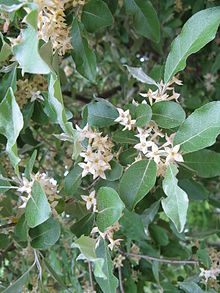
After 3 years of growth, the Autumn Olive bears fruit. You should look to start harvesting it somewhere in September, usually around the Fall equinox (if you live in Zone 6a like I do). A good year of fruit can have up to 8 lbs of fruit per bush (I have found that in Michigan, we only get this kind of abundance every few years). The fruit is really delicious and tart and not really like anything else out there. The closest thing I can think of is a cranberry, but autumn olives have no bitterness and are more tart.
Autumn Olives flower in the spring, and have quite a pleasant smell and nectar that my bees certainly appreciate. Seeing how many flowers there are in the spring should give you an idea about how much fruit you will find in the fall. Sometime in early September to mid October, the berries ripen going from green to orange to a dark red. It is when the whole bush is red, a deep red, and the berries are ready to fall off (and you see the birds eating them), that they are ready to pick. If you see orangish berries still on the bush, its not ready, and you should wait a few days. Tasting the bush will confirm this–even the red berries on a bush with orange berries aren’t going to be a sweet.
Be sure to pick ripe bushes before a big rain….if the fruit are quite ripe, they fall off the bush easily and a hard rain will knock them all to the ground. I had a bush I was enjoying this year, the first to ripen on my property a few weeks ago. A big storm came and dropped them all to the ground before I was able to harvest them!
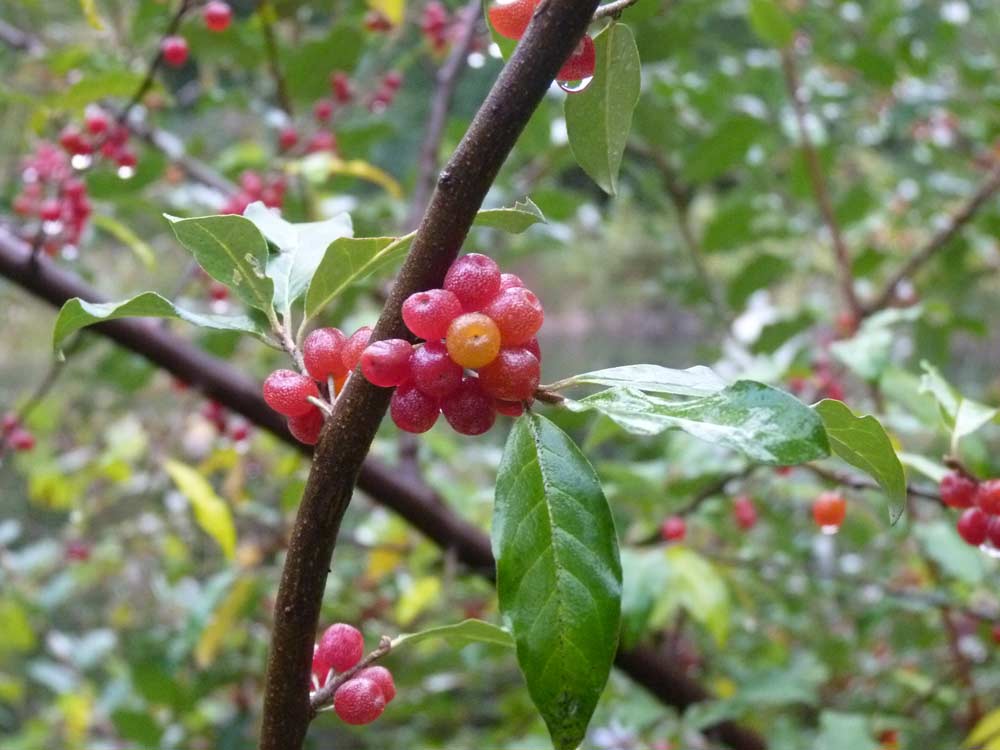
Each bush also tastes slightly different–some are more tart, some are more sweet, some are more flavorful. When I am picking, I will go from bush to bush and taste a berry or two on each one. When I find a bush that tastes good, that’s the bush I pick (they are so abundant that I can skip bushes if I want). If the fruit on a particular bush tastes too astringent, wait a few days and come back–it should ripe up soon enough. I love the diversity of flavors that the different bushes produce, and so, I have certain “favorite” bushes I visit each year.
In a good year, two people can pick several or more of autumn olive in an hour or so (our record is in the photo above–10 gallons in one hour with three people But that is a bit of a rarity. More likely, it’s about a gallon per person per hour. In any year, the autumn olive is absolutely worth your time to pick. Autumn olive makes the fantastic jelly and fruit leather due to its tart quality.
Autumn Olive Jelly
I’m going to walk you through the process of making an Autumn Olive Jelly, with photos, because this is one of the best ways to preserve these delightful fruits. One thing about the jelly–the fruit juice tends to separate from the fruit pulp as it sets, so you get these interesting mottled-looking jars of jelly. I think they look kinda cool, but they might be a turn-off (and frankly, that’s fine, because that’s more jelly for me).
Ingredients:
- A bunch of autumn olives, washed
- Pomona’s pectin (described in this post)
- 1/2 cup – 1 cup honey per 4 cups of processed berries
Equipment:
- Hot water bath canner
- 1/2 pint or 1/4 pint jars with new lids
- Food mill
- Masher (wooden or potato)
1. Wash and prepare your berries. You want to wash your berries and also sort through them to make sure you don’t have any foreign objects, bugs, etc. This process is called “garbling” (and I have no idea where that term came from).
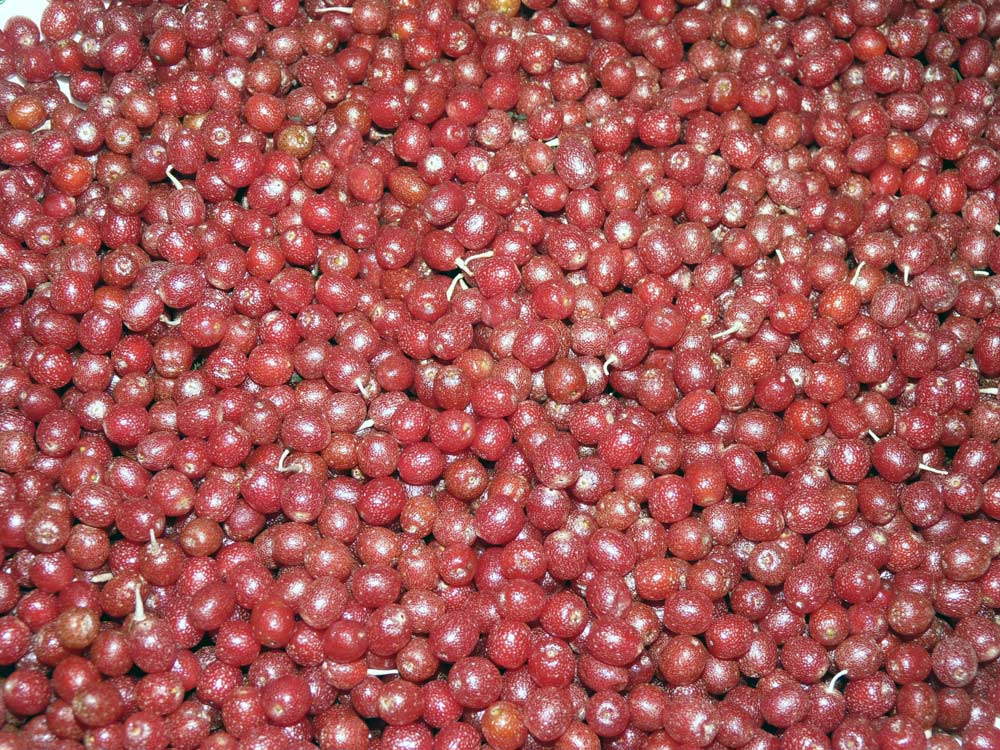
2. Add them to a big pot and begin cooking. Add them to a big pot and put your burner on medium-high.
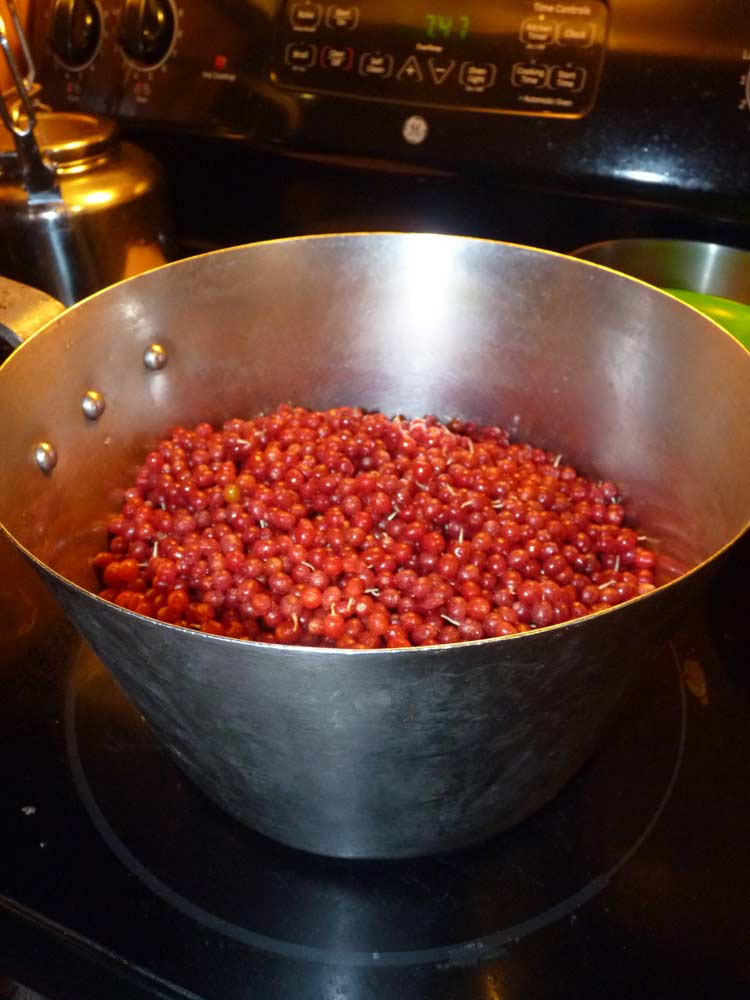
3. Cook and mash your fruit. You want to cook down the berries so that they are hot, and mash them down as you are cooking. Make sure to stir often so you don’t burn your berries. Once they get good and watery and they are broken up, continue onto step 4.
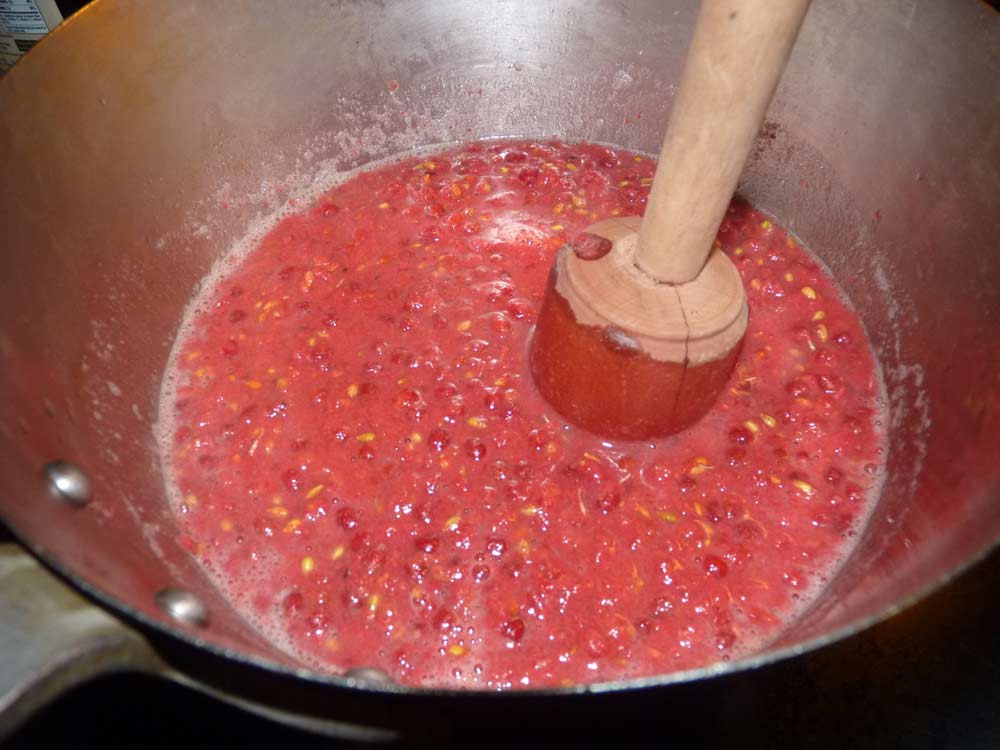
If you don’t want to mash your berries by hand, the alternative is to use a stick blender. This makes VERY short work of the berries, but you will still need to cook them down a bit to have them go through the food mill or through a mesh strainer. Before they are cooked, they don’t get as smooth as after, and that makes it hard to get the seeds out. Be careful you don’t splatter them everywhere….I left a real mess in the kitchen this day.
4. Use a food mill or metal strainer/wooden spoon to remove seeds. You will need to get the seeds out of the mash, and I find using a food mill works really well for this purpose. You’ll notice that the juice of the autumn olive tends to separate from the pulpy fruit and skin–that’s just how it is. Here’s a photo of the food mill in action:
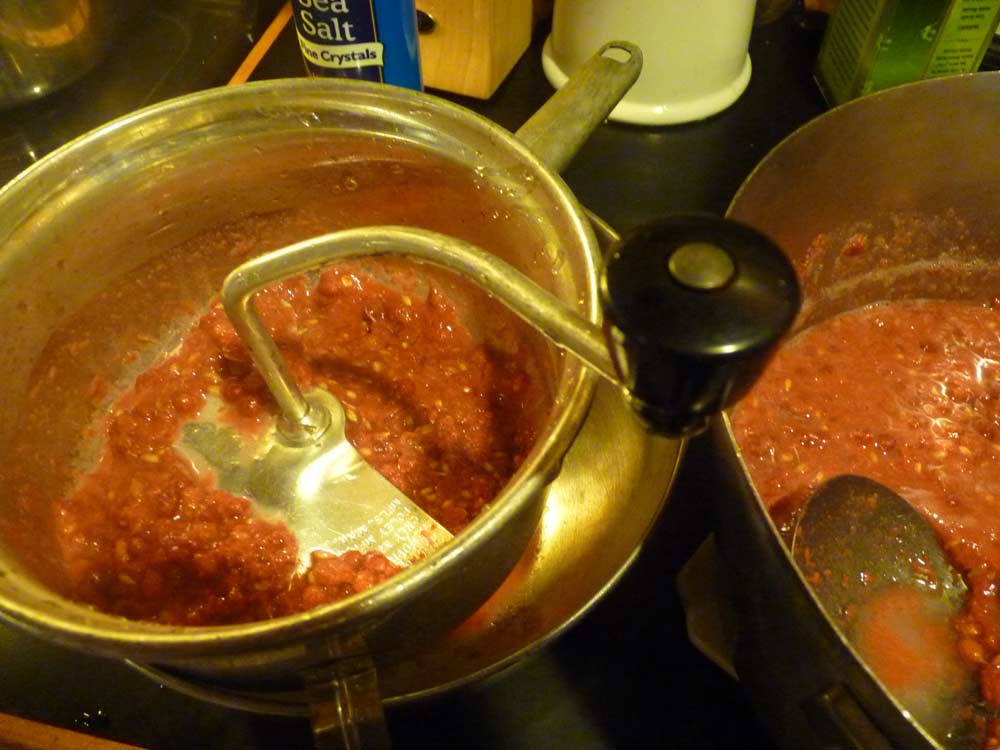
The alternative is to use a metal strainer and a wooden spoon. Get a strainer with pretty large holes–it makes it MUCH easier. One like the one in the picture works well–I processed 6 gallons of berries using this method in less than an hour.
5. Prepare canner and lids. Measure out autumn olive juice and get it back on the stove. You need to measure out your juice so that you know how much you have for the purposes of adding pectin. The juice will be this awesome beautiful pinkish red…it might have foam. That’s ok. I will explain what to do with that in a bit.
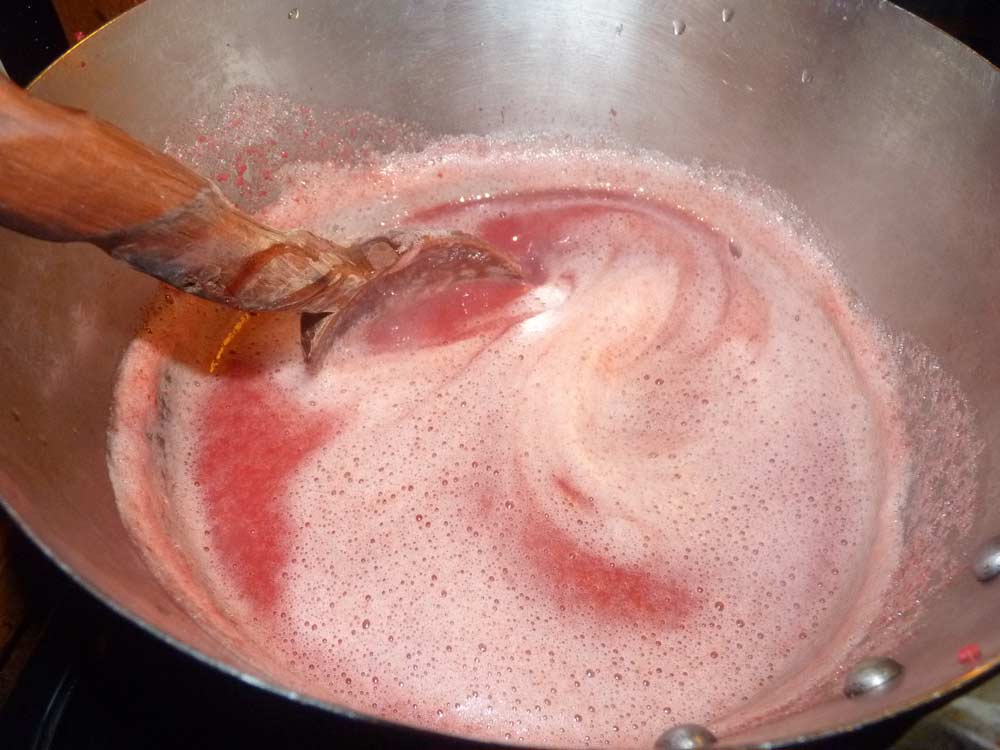
6. Prepare pectin: add calcium water to mixture. You might notice that many recipes call for nearly 50% sugar. I don’t find these recipes healthy; they are too sweet and full of calories. The sugar masks the real quality taste of the berries. I found pectin called Pomona’s pectin – it allows you to can with much less sugar or to can with honey or maple syrup. So for this recipe, we are using Pomona’s pectin. You can follow the directions on the label that are specific for jelly (like using grape juice). To use this pectin, you will mix up calcium water and add it to the fruit. Next you mix the pectin itself into the honey. Finally, you mix the honey into the berry juice and bring it to a boil for a short amount of time. You can use the ratios on the instructions; I found that only a little honey is needed so I have been using 1/2 cup honey to four cups autumn olive mix. You can also add a little lemon juice–that makes a really nice addition to the jam.
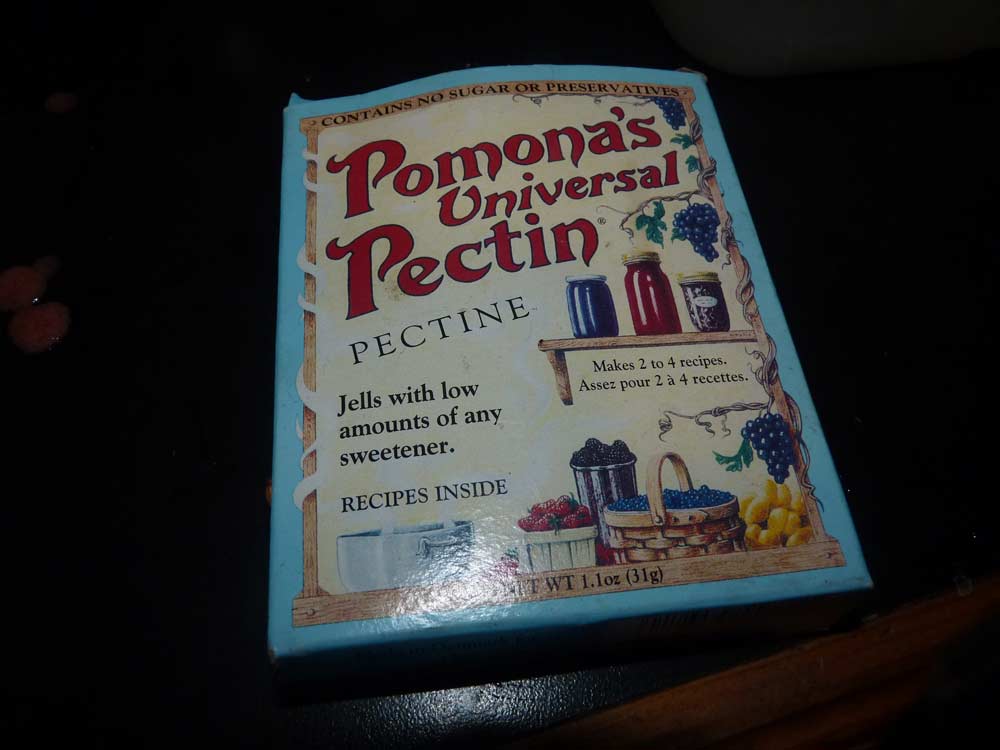
7. Add mixture into jars and hot water bath process for 20 min (1/2 pints). If you have foam at this point, you can skim it off and put it in a jar. It will solidify, and then you’ll have a delightful treat to eat with a spoon. You can store the foam in the fridge and enjoy a scoop whenever you like.
8. While jars are processing, lick the spoon and enjoy the leftovers in the pot. Trust me, you don’t want to skip this step.
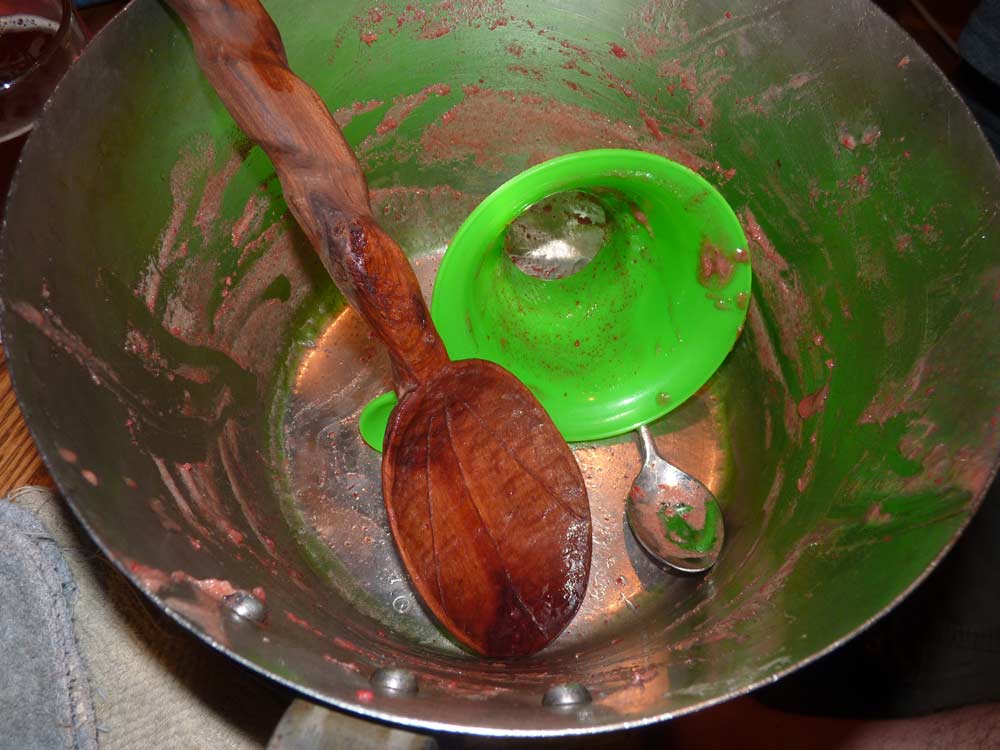
9. Pull out of canner, wait till jars seal, and enjoy! You will notice that autumn olive separates a bit as its sets. This is perfectly normal, but does look a bit weird. The good news about it looking weird is that if someone is going through your cabinets looking for something to eat, they might be less inclined to eat your autumn olive jam, so I consider this a natural defense mechanism. The jam is delicious!
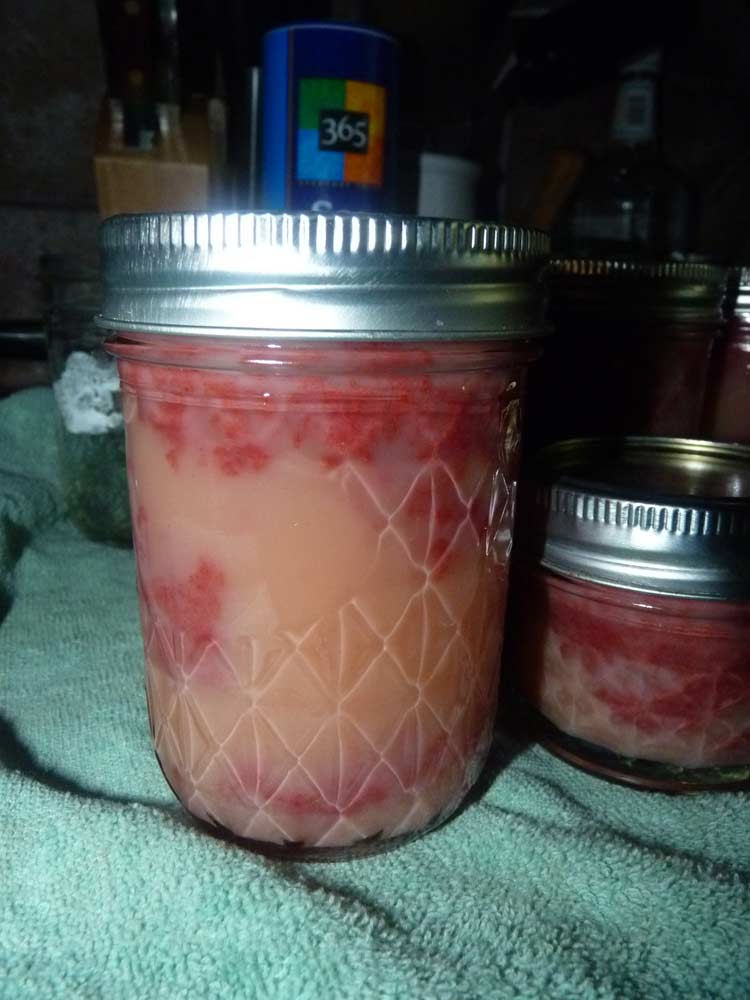
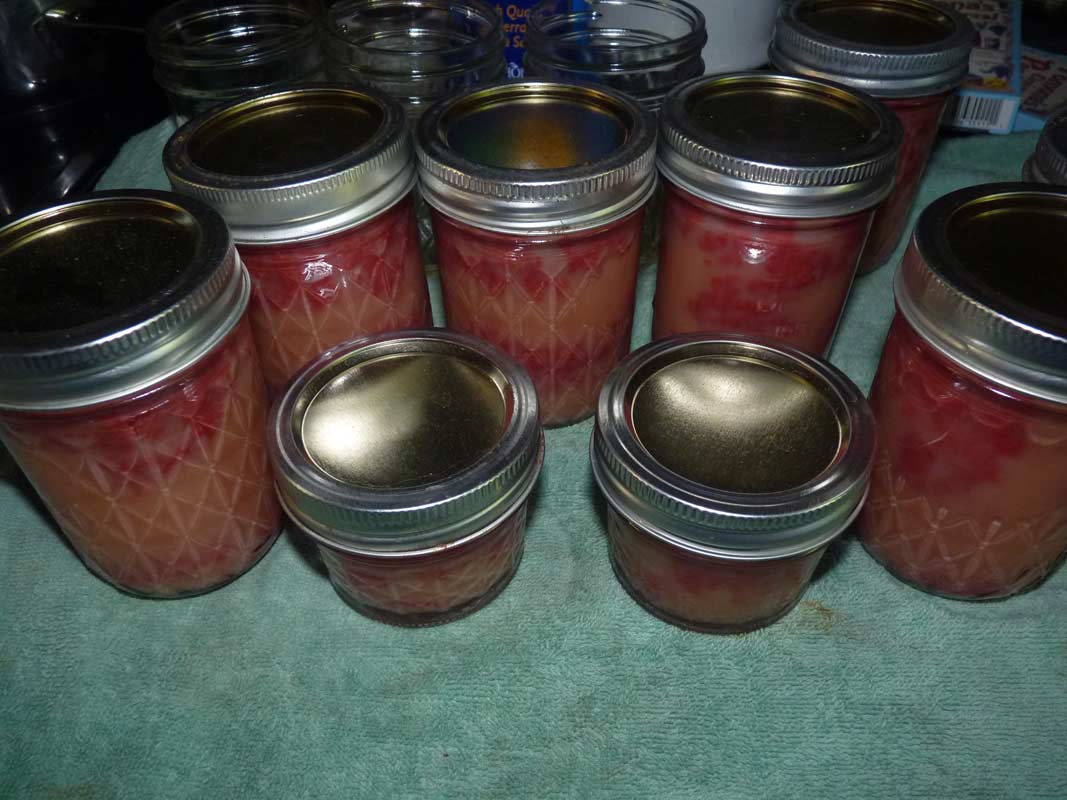
Now if you strained this, you could probably get rid of the spoltchyness and only have one color of jelly. But I like the way it looks, with its interesting patchwork colors and shapes. Enjoy this often!
Finally, I want to direct you to also read Sam Thayer’s Autumn Olive page, because he has a lot of great info on this wonderful plant in terms of pounds per acre and so on. He suggests that some are considering commercial cultivation of these wonderful fruits because of their vitamin and mineral content, nitrogen-fixing ability to regenerate the soil, and potentially high yields.
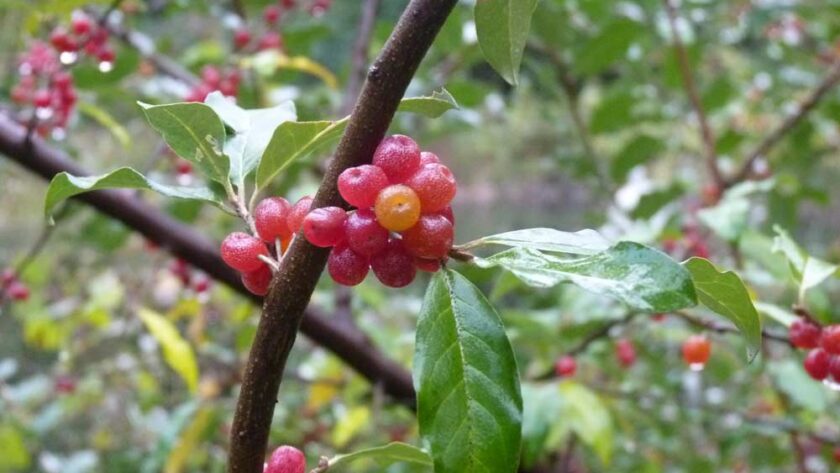
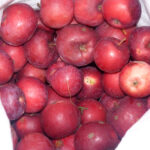

Very interesting! They sound good, don’t think I’ve ever seen any around here. Have a lovely day.
I am certain you do have them around you–they are extremely widespread in this region 🙂 Go out to some parks and take a look–look in fields, abandoned old fields, wasteland, on the edges of things…you will find them laden with fruit!
I just learned about autumn olive from a new acquaintance and I was going to ask if you knew about it–I should have known! I’ve tried making fruit leather and it’s wonderfully easy except that I lack a food mill, which will be my next investment.
Karen, I found a simple food mill at a garage sale for $2 :). I think you can also look at Salvation Army and the like 🙂
You have given a beautiful perspective of the Autumn Olive. Really appreciated the article……Thanks
Thank you for your kind words, Linda! I hope you can find a few to nibble on and enjoy :).
i picked a batch back in September when the fruits were a lighter colour and the jam did separate. Here we are a month later and I made jam again, using evaporated cane juice (I like the molasses quality) and the zest and juice of orange. Don’t know whether it’s the reaction of the orange and Autumn Olive or the extra sugar but my jam is rich, plum red and doesn’t separate…and the Orange-Autumn Olive taste blend is Wonderful!
Hmm….that’s interesting. I made several batches this year, all with fairly ripe autumn olives. I used honey in the batches with Pomona’s pectin. The jam all separated, some batches worse than others.
I should totally try the orange juice and cane juice approach. What was the ratio that you used for cane juice?
Full Disclosure: Our family farm was among the first to cooperate with West Virginia’s erroneous program to introduce this species, and our regrets continue to this day.
You’re right about the flavor, and I’ve eaten many of these in delicious recipes. So have the birds, which is the primary method of spreading it absolutely everywhere … and, you couldn’t be more wrong about it’s negative impact, unless you were among those that suggested it then: Presuming yourself wiser than nature, herself, is the most common mistake man continues to make, and you’re as guilty as they were.
I refuse to resort to herbicides, but for every acre I clear? There’s two covered over … it never stopped erosion, but instead? Blocks the sun, and shades out all that would actually hold and build soil; it strips away all natural life from beneath, and splits the stones beneath — to uproot larger shrubs requires holes big enough to bury those responsible for it’s introduction, which crosses my mind as I endlessly work to undo some of the damage they’ve done.
The best things to make of it? Mulch, and fire.
Thanks for your comments, Daniel. I appriciate your perspective, and I’m sorry to hear that you have been battling it for a long time. I certainly don’t presume to be wiser than nature, rather, I learn my lessons from nature.
My take on this is this: we have it here, and it isn’t going anywhere, and so, I’m going to use it and eat it. If you can’t beat it, eat it, right? There are some folks who are looking to market autumn olive (like these folks: http://www.autumnberryinspired.com/). I wonder if it could be turned into a productive crop on a wider scale. As you say, it isn’t going anywhere, so we might as well do something positive with it.
Hi, Dana, and to be more clear? I mean that we (meaning all of us that try to interact with our environment in a positive way) tend to think what we’re doing is gonna improve upon nature … and even when we do the right things? There’s nearly always negative impacts.
That’s why the only bee hives found on this farm are native wild ones — since nobody’s quite determined the reason(s) so many honeybees keep dying. I will be adding to the Mason bees’ populations, but only with those already found here.
Which brings me back to what you’re doin’ with that fruit … satisfying, to see it consumed by humans, rather than the birds that spread it everywhere. But, I’d sure hate to see folks adding it where it isn’t currently found.
I’m buying a Tazz K52 , which appears to be the best shredder for my money, and will turn the new growth of our Autumn Olive into an excellent mulch for the gardens, since it contains nothing to inhibit the growth of other plants, and is especially high in Nitrogen. And, those larger limbs contain an oil that make ’em burn hot, even when green.
I, too, adjust to the reality that it’s still gonna be here long after I’m gone, soOo … yeah … might as well make use of it.
Daniel,
Yeah, we need to learn to work with nature, rather than against her (or in ignorance of her). I have a lot of hope, however. I’ve watched what happens even over a decade or two when humans just leave the land to heal. She can heal, and over time, she will find her balance, regardless of what we do. I hope that will continue to be the case, even as ecosystems are breaking down.
Also, not sure if I mentioned this before, but there are a group of permaculturists working to test how well Autumn Olive sinks carbon into the soil. When you trim autumn olive, like most plants, it sheds roots to compensate. Their research is ongoing, but the theory is that if you cut them back entirely (and turn them into mulch, hugels, biochar, etc), they’ll keep sinking carbon and then you let them regrow for a few years and cut them back again, etc. I don’t know if this is do-able on the scale you are talking about, but it is another possibility.